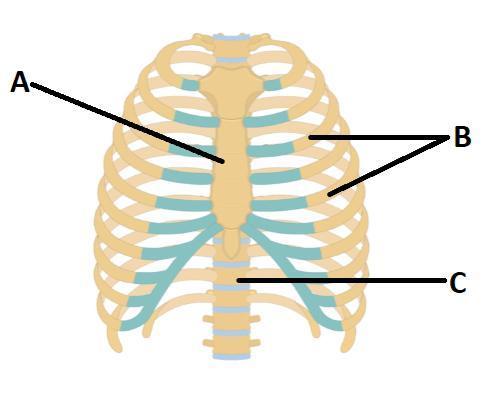
Answer
442.8k+ views
Hint:The rib cage provides protection to the vital organs present in the thoracic cavity. It expands when we breathe in and relaxes when we breathe out. The ribs protect our heart and lungs.
Complete answer: The rib cage is the arrangement of ribs attached to the vertebral column at the back and sternum in the front in the thorax of vertebrates. It protects and encloses the heart and lungs. In humans, it is also known as the thoracic cage. It is a bony and cartilaginous structure that encloses inside it, the thoracic cavity. It also supports the shoulder girdle to form the central or main part of the human skeleton. It consists of –
24 ribs that are arranged in 12 pairs
The sternum
The xiphoid process
The costal cartilages
The 12 thoracic vertebrae
So, in the figure, the bone labeled as A refers to the Sternum or the chest bone. The bones labeled as B are the Ribs. The bones labeled as C are the Vertebral column.
So, the correct answer is option B.
Additional information:
The ribs are 12 pairs, of which the first 10 pairs are true ribs. These are attached to the vertebral column at the back and to the sternum in the front. The remaining 2 pairs are called false ribs or floating ribs. They are attached to the vertebral column at the back but not to the sternum in the front.
Note: The rib cage is a structure of a lot of importance for protection to the lungs and heart. The true ribs form the chest cavity. The floating ribs do not contribute to the chest cavity.
Complete answer: The rib cage is the arrangement of ribs attached to the vertebral column at the back and sternum in the front in the thorax of vertebrates. It protects and encloses the heart and lungs. In humans, it is also known as the thoracic cage. It is a bony and cartilaginous structure that encloses inside it, the thoracic cavity. It also supports the shoulder girdle to form the central or main part of the human skeleton. It consists of –
24 ribs that are arranged in 12 pairs
The sternum
The xiphoid process
The costal cartilages
The 12 thoracic vertebrae
So, in the figure, the bone labeled as A refers to the Sternum or the chest bone. The bones labeled as B are the Ribs. The bones labeled as C are the Vertebral column.
So, the correct answer is option B.
Additional information:
The ribs are 12 pairs, of which the first 10 pairs are true ribs. These are attached to the vertebral column at the back and to the sternum in the front. The remaining 2 pairs are called false ribs or floating ribs. They are attached to the vertebral column at the back but not to the sternum in the front.
Note: The rib cage is a structure of a lot of importance for protection to the lungs and heart. The true ribs form the chest cavity. The floating ribs do not contribute to the chest cavity.
Recently Updated Pages
Fill in the blanks with suitable prepositions Break class 10 english CBSE

Fill in the blanks with suitable articles Tribune is class 10 english CBSE

Rearrange the following words and phrases to form a class 10 english CBSE

Select the opposite of the given word Permit aGive class 10 english CBSE

Fill in the blank with the most appropriate option class 10 english CBSE

Some places have oneline notices Which option is a class 10 english CBSE

Trending doubts
Fill the blanks with the suitable prepositions 1 The class 9 english CBSE

How do you graph the function fx 4x class 9 maths CBSE

When was Karauli Praja Mandal established 11934 21936 class 10 social science CBSE

Which are the Top 10 Largest Countries of the World?

What is the definite integral of zero a constant b class 12 maths CBSE

Why is steel more elastic than rubber class 11 physics CBSE

Distinguish between the following Ferrous and nonferrous class 9 social science CBSE

The Equation xxx + 2 is Satisfied when x is Equal to Class 10 Maths

Differentiate between homogeneous and heterogeneous class 12 chemistry CBSE





